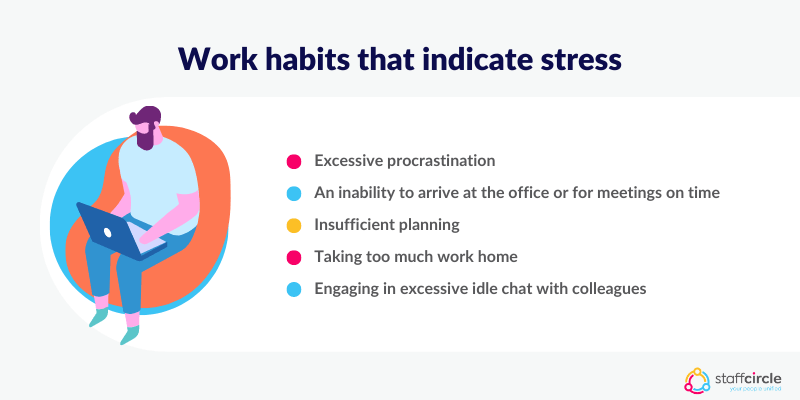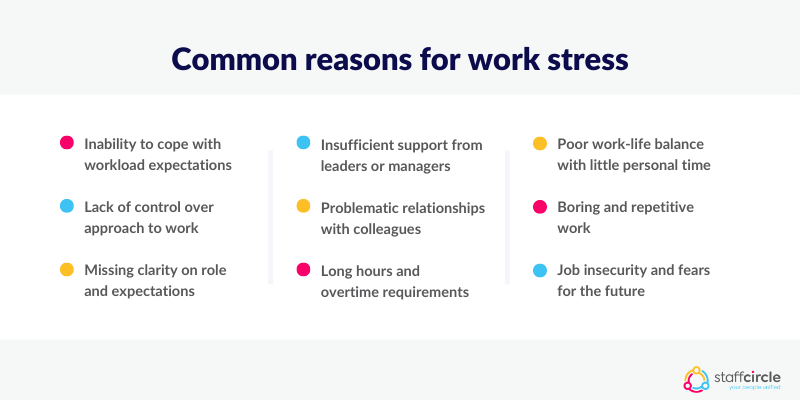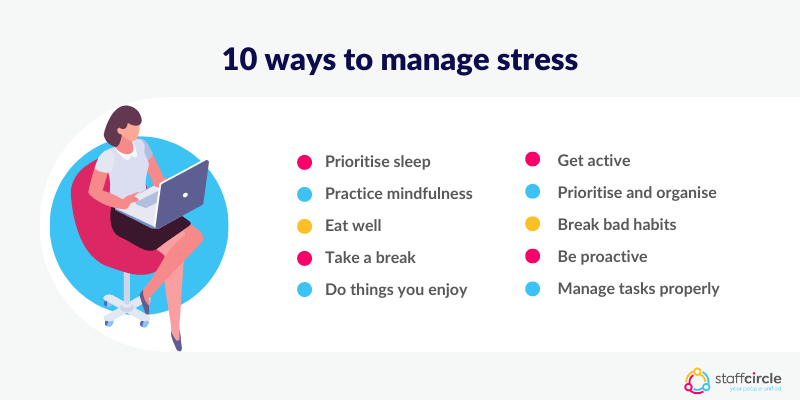Dealing with work stress can have potential huge emotional and financial costs, impacting productivity, engagement, and employee turnover. It is essential that business leaders and HR professionals are equipped with the means to spot and manage stress in the workplace.
Read on to discover 10 simple steps for dealing with work stress, from encouraging a healthy lifestyle to helping employees better prioritise their workloads.
Overview
Stress can lead to serious physical health and mental health problems for employees. Whether this is work-related stress or stress caused by issues in an employee’s personal life, it can impact performance, engagement, and motivation in serious ways.
Fortunately, there are various steps employers and employees alike can take to minimise the impact of stress. This guide will help you to identify the warning signs of work-related stress, reduce the likelihood of stressful situations, and manage it when it does arise.
Work-related stress: Why it’s a problem
Stress has long been acknowledged as a common source of poor business performance. The article from Forbes magazine, How Stress Is The Business World’s Silent Killer, discusses Stanford professor Jeffrey Pfeffer’s research on the subject:
“The financial cost of unhealthy workplace exposures are rarely taken seriously in most organizations. And yet, looking at it from a purely quantitative point of view, the numbers are not pretty. “Workplace environments in the United States ….account for about $180 billion additional health-care expenditures, approximately 8 percent of the total health-care spending.”
Countering the financial and emotional costs of excessive workplace stress requires a multi-faceted approach. It involves developing an understanding of the importance of well-being and incorporating a range of methods for stress management in the workplace.
Stress at work: The warning signs
Stress in the workplace can be caused by a range of circumstances. But the warning signs of stress are essentially the same whatever the root cause and managers can be better prepared to take action when they know what to look out for. Likewise, employees should be aware of these signs so they can speak up if they feel as if stress is beginning to overwhelm them.

Some of the warning signs of stress to look out for include:
- Increased heart rate and/or chest pain, or a general feeling of heaviness in your chest
- Persistent headaches or migraines
- Clenching your jaw or grinding your teeth
- Light-headedness and/or dizziness
- Feeling excessively tired and drowsy
- Experiencing feelings of anxiety or depression
- Body aches and pains, including pains in the shoulders, neck, or back
While these signs aren’t exclusively linked to stress, experiencing one or more of these on a consistent basis is an indication that stress might be at play.
Common reasons for work stress
Stress can be caused by a wide range of factors, both in the workplace and in an employee’s personal life. In general, these factors relate to issues of demand, control, support (or lack thereof), and relationships, in addition to the expectations from a person’s role.

The UK government’s Health and Safety Executive issued a report on work-related stress and how to manage it, exploring some of the more common reasons for work stress.
These include:
- An inability to cope with the workload expectations of a given role
- A lack of control over how they are able to approach their work
- Missing clarity on their role and expectations due to a lack of information
- Insufficient support from team leaders and managers
- Problematic relationships with colleagues, which in extreme cases can include bullying
- Long hours and overtime requirements lead to burnout
- A poor work-life balance with little time for personal lives
- Boring and repetitive work
- Job insecurity and fear of what the future might hold
These and other factors can all lead to workplace stress, negatively impacting an employee’s physical and mental health and overall well-being.
10 ways to manage stress
Now that a clearer idea of the various potential causes and signs of stress have been explored, let’s dive into the 10 effective ways to manage stress.
Prioritise sleep
One of the leading causes of stress and anxiety is a lack of sleep. When employees aren’t firing on all cylinders, they make more mistakes, become more irritable, and are more prone to experiencing stress.
To minimise the chances of stress, make sure sleep patterns are prioritised so employees can start the day feeling refreshed and invigorated. If someone isn’t getting enough sleep, encourage them to increase their sleep by 60 to 90 minutes each night to make sure they are healthy and happy.
Practice mindfulness
Mindfulness is a variation of meditation that can easily be practised in the workplace by finding a quiet room, even for just a few moments. It can involve simple breathing exercises or the use of guided imagery to help bring about a feeling of calm and relaxation.
Encourage staff to engage in simple mindfulness exercises on a regular basis, or if they are sensing the signs of stress impacting their performance
Eat well
Just as a lack of good sleep can lead to higher levels of stress, so too can a poor diet lead to stress due to a lack of good nutrients and other essential vitamins and minerals.
A study from Harvard’s School of Public Health discusses the relationship between stress and health, and the role food plays in regulating stress to low levels. The study explains:
“Chronic stress can affect the body’s use of calories and nutrients in various ways. It raises the body’s metabolic needs and increases the use and excretion of many nutrients. If one does not eat a nutritious diet, a deficiency may occur. Stress also creates a chain reaction of behaviors that can negatively affect eating habits, leading to other health problems down the road.”
As well as encouraging employees to eat well and stay hydrated, business leaders can take additional steps, for instance by providing access to fruit and other healthy food in the company’s kitchens and shared spaces.

Take a break
One of the most obvious steps that can be taken to manage stress, particularly when an excessive workload is a cause, is to take a break. Even a short respite from the daily grind can be enough to alleviate feelings of stress and allow a person to resume a productive working day.
For on-site workers, provide access to a staff room or other space where they can get away from their desks for a few moments. If the weather is good, encourage them to get outside for some fresh and, if time permits, go for a walk.
Do things you enjoy
A poor work-life balance can easily lead to stress, particularly if the balance is almost entirely skewed towards work. When this is the case, employees can feel drained and stressed, lacking the necessary physical and mental space to unwind.
Employers can encourage staff to cultivate hobbies and interests through the company forum and intranet. This can extend to scheduling fun staff activities and outings where they can strengthen social relationships and bond with one another over shared interests.
Get active
Another effective way to enhance staff well-being is to encourage physical activities. Many companies host schemes to encourage cycling to work, helping employees cover the costs of a bicycle so they can enjoy a healthier commute.
There are a wide range of additional activities that companies can actively encourage in order to promote a more active and healthy lifestyle. Discounts for gym memberships, regular office yoga sessions, and introducing standing desks into the workplace are just a few examples of ways businesses can promote physical activity.
Prioritise and organise
When employees are uncertain as to what their expectations are, stress can creep in. This is often not related to having too much work, but rather poor organisation and scheduling. Focusing on creating a clear schedule can help ensure employees always have their focus on the right thing.
Break bad habits that contribute to workplace stress
There are various bad habits people develop at work that can lay the foundation for stress. Understanding what these are, and then taking the necessary steps to break them, is an important aspect of lowering workplace stress.
Some bad habits to look out for include:
- Excessive procrastination
- An inability to arrive at the office or for meetings on time
- Insufficient planning
- Taking too much work home
- Engaging in excessive idle chat with colleagues
Encouraging employees to take stock of these bad habits and work to reduce their effects on their work will help lower overall feelings of stress.
Be proactive about your job and your workplace duties
Passively engaging with work is a surefire way to increase the chances of stress. Lack of engagement and enthusiasm inevitably leads to boredom and other negative emotions that stress feeds upon.
Encourage your employees to adopt a proactive mindset about their work, suggesting ways they can improve their workflow and develop more agency over their duties. Employees who take this approach are more likely to innovate and will find their jobs rewarding and creative.
Manage tasks properly
Juggling multiple tasks and objectives can lead to confusion and stress, and some employees are less adept at doing so than others. Effective task management gives employees a sense of control over their day, reducing the likelihood of feeling overwhelmed and stressed by their workload.
Performance management software is an easy way to achieve this and can be used to set goals as objectives and key results (OKRs) or key performance indicators (KPIs). These tools help employees track and update their progress towards both work and development goals, coordinating with their direct reports in real-time.
In Summary
With physical and mental health and wellbeing becoming increasingly important to employers and employees alike, recognising the tell-tale signs of stress is essential. Great companies are capable of reducing stress and anxiety so that their employees can deliver their best performance.
This guide should help business leaders and managers to stop the signs of stress early, allowing for effective and timely intervention to nip the problem in the bud.





